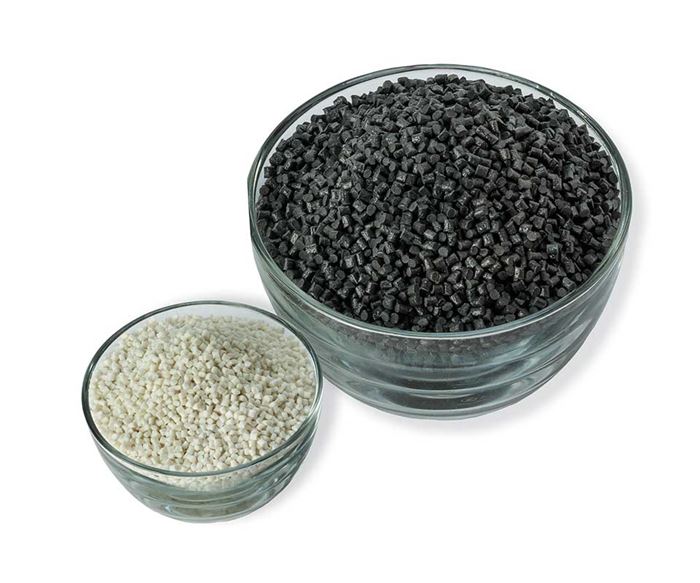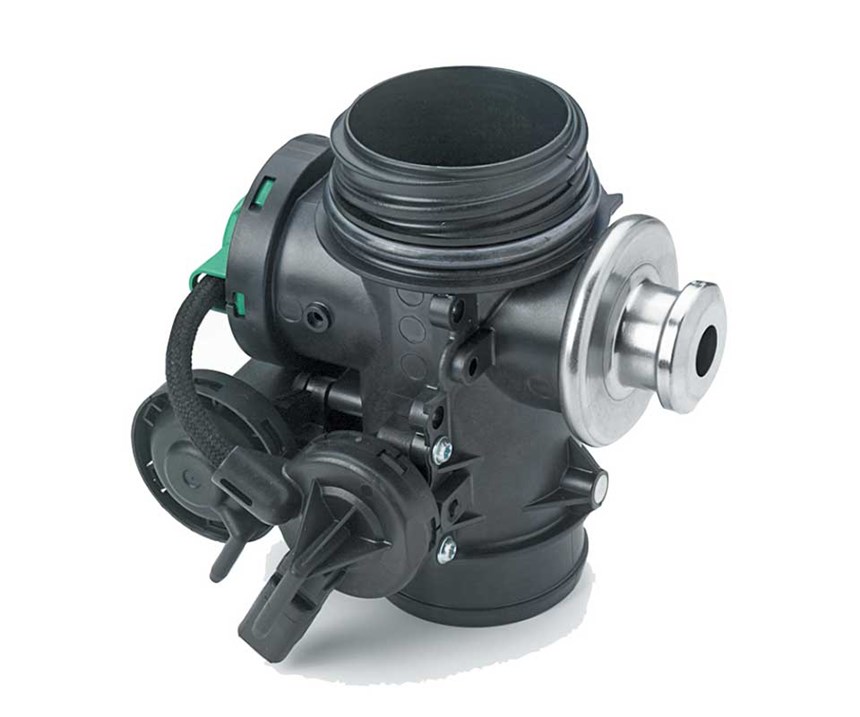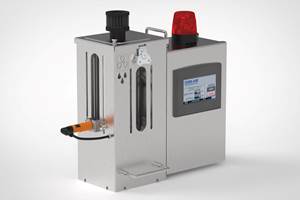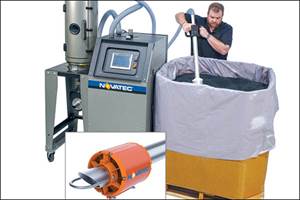What You Need to Know About Drying Specialty Nylons
PPA is being used more frequently by molders for demanding high-heat applications in automotive and other markets. While in the nylon family, it does not dry quite like nylon. Follow these tips.
Basic chemistry dictates that the strength of molded parts partly derives from the entanglement of the long polymer chains that comprise the base resin. Hygroscopic engineering resins, such as PBT, PET, PC and nylons, all absorb ambient moisture that can effectively shorten their polymeric chains and adversely affect performance in both the mold and the end part.
The aliphatic amine molecule of nylons, in particular, lacks the aromatic ring directly on the molecule’s nitrogen atom, which makes them particularly susceptible to picking up moisture. If excess moisture is not removed, the presence of heat and pressure during molding can cause hydrolysis, which degrades the polymer or causes chain scissions that produce excessive outgassing, splay marks, or discoloration and compromise the physical integrity of the finished part.
A number of specialty resins, such as polyphthalamide (PPA), have significant amounts of aromatic character in their polymeric backbone, which causes them to absorb less moisture than aliphatic nylons like nylons 6 and 66, and do so at a slower rate. The diffusion coefficient for water in some grades of Solvay’s Amodel PPA, for instance, is approximately 20% that of nylon 66 at 73°F (23°C). Put another way, PPA generally will not absorb more than 1.5% of its weight in moisture, while nylon 6 can hold up to 7%. Yet PPA resins are still considered hygroscopic and require proper drying prior to processing.
It is important to emphasize that there is more at stake here than simply getting unwanted moisture out. There is such a thing as drying a resin too much. Ultimately, the aim is to ensure maximum polymer performance, which is especially important if your design calls for a specialty polymer like PPA. This also applies to less hygroscopic specialty resins like polyamide-imide (PAI) and even non-hygroscopic polymers, like polyphenylene sulfide (PPS).
Although PPS is hydrolytically stable, pellets may pick up some surface moisture during shipping or storage that may result in cosmetic defects, such as surface streaks or splay marks on injection molded parts or severe bubbling or streaking in extruded profiles. Further, surface moisture can vaporize into steam within the barrel of an injection molding machine, creating internal pressures that force nozzle drool. Lastly, it is important to remember that many mineral fillers are hygroscopic and can make reinforced compounds more susceptible to moisture-driven drool even if the base resin is stoutly non-hygroscopic.
ROLE OF DRYING EQUIPMENT & TECHNIQUE
The first step toward optimal drying of hygroscopic resins is to prevent moisture absorption in the first place. Amodel PPA, for example, is shipped with less than 0.15% moisture in vacuum- sealed, aluminum-lined containers that prevent moisture ingress. Once opened, it is critical to reseal packaging containers as quickly and as tightly as possible. Many suppliers provide tools to help molders gauge how long they should dry a resin based on how long its container has been open.
Equally important is that bags should be opened individually and immediately loaded into a hopper dryer. Opening several bags to allow air conveyors to transfer the resin to the hopper as needed allows the resin to pick up moisture. When loading resin from large containers, it is best to cut just enough of the foil liner to fit an air- conveyor wand into the package, and then reseal the foil around the top of the wand. Only dried air—as opposed to “shop air”—should convey resin.
More exacting applications may require measurement of resin moisture content prior to molding. Karl Fischer titration, which uses a moisture-reactant chemical, offers an efficient, rapid,
and highly precise method for determining water content in resins. Gravimetric moisture analyzers, while less precise than titration, may be more suitable for a manufacturing setting. These devices comprise a sensitive weigh scale embedded within a benchtop drying oven to measure how much weight the resin loses during drying. While relatively fast and inexpensive, gravimetric analysis is not moisture-specific. So, its measurement may be distorted by the evaporation of other volatile components in the resin.
The range of options for drying resin is even more diverse, but they take one of three approaches: heat, chemical desiccation, or vacuum pressure. All are suitable for drying specialty resins.
• Hot-air dryers are the most effective in removing surface moisture and therefore are suitable for non-hygroscopic polymers such as polyolefins, polystyrene, and PVC.
• Desiccant dryers have long been the workhorse for drying resins that absorb moisture, and generally include some configuration of a moisture-removal filter or bed that recycles dry air through the system in a closed loop. Single-bed desiccant systems are adequate as long as the desiccant is replaced as necessary, but dual-bed systems allow regeneration of one bed while the other is drying. Another variation incorporates a rotor that exposes different sections of a rotating desiccant wheel to process air, regeneration or cooling. Rotating or wheel designs absorb moisture at a more constant rate than a conventional desiccant bed, which helps to minimize spikes in dewpoint or temperature.
• Low-pressure or vacuum dryers heat pellets just enough to dislodge moisture from the resin’s molecular structure, and then draw it off under vacuum. These systems can dry resins in a fraction of the time it takes other dryers, thereby saving energy and minimizing the prospect of discoloration from heat.
Regardless of the technique, the key metric for effective drying is dewpoint, which equates with ambient moisture. That is, the lower the dewpoint, the less moisture there is in the air inside the dryer. The ideal dewpoint for drying most resins, including PPA, is -40°F/°C. As long as the dryer’s dewpoint remains fixed, however, time and temperature can be used to calculate when the resin is adequately dry for processing. This may vary from polymer to polymer.
For PPAs, the drying time and temperature depends on the moisture content of the resin, the size of the hopper dryer used, and the throughput of the molding process. To determine the proper drying temperature, divide the capacity of the hopper dryer (in lb or kg) by the rate of resin consumption (in lb/hr or kg/hr). This will determine how long the material should remain inside the dryer, which in turn determines the drying temperature. Figure 1 shows recommended drying time and temperature for Solvay’s Amodel PPA resins when their sealed shipping container is opened.
For most uses, the specified dryness is 300 ppm (0.03%) for Amodel PPA resin. However, this specification may be tighter for some applications, such as extruded monofilament, which requires the resin to be extremely dry.
As previously mentioned, it is possible to overdry PPA and other resins, thereby solid- stating the material or increasing its molecular weight. This typically leads to increased viscosity or lower flow, which may result in short shots, increased pressure required to fill, and inconsistent processing. It is best to find the equilibrium temperature where uniform moisture can be maintained without over drying. The low-end tolerance for Amodel PPA is 100 ppm (0.01%) moisture content. Once a resin has been adequately dried, it is important to maintain relatively constant moisture levels throughout the molding run to ensure process and part uniformity. Melt viscosity is influenced by the amount of moisture in resin. More moisture equates with a lower melt viscosity (see Fig. 2).
Moisture levels upwards of 0.15% can cause cosmetic problems such as splay or silver streaking on the surface of a molded part. Higher levels can lead to hydrolysis, and result in a significant reduction in mechanical properties. This is clearly an issue for any molder. But it underscores the importance of proper drying techniques when specifying specialty resins like PPA, which are often selected for the most demanding applications.
ABOUT THE AUTHORS: William Hamm and Edgar Benjamin are both technical development engineers in Solvay’s Specialty Polymers global business unit in Alpharetta, Ga. They bring nearly 50 years of combined experience in polymer technology. Contact: 770-772-8200; William.hamm@solvay.com and edgar.benjamin@solvay.com; solvay.com;
Related Content
A Cost Saving Modular Approach to Resin Drying Automation
Whether implementing a moisture-sensing closed-loop system for a single dryer, or automating an entire plant, technology is available to take the guesswork and worry out of resin drying. Using a modular approach allows processors to start simple and build more capabilities over time.
Read MoreWhy (and What) You Need to Dry
Other than polyolefins, almost every other polymer exhibits some level of polarity and therefore can absorb a certain amount of moisture from the atmosphere. Here’s a look at some of these materials, and what needs to be done to dry them.
Read MoreNew Technology Enables ‘Smart Drying’ Based on Resin Moisture
The ‘DryerGenie’ marries drying technology and input moisture measurement with a goal to putting an end to drying based on time.
Read MoreRead Next
How Polymer Melts in Single-Screw Extruders
Understanding how polymer melts in a single-screw extruder could help you optimize your screw design to eliminate defect-causing solid polymer fragments.
Read MoreAdvanced Recycling: Beyond Pyrolysis
Consumer-product brand owners increasingly see advanced chemical recycling as a necessary complement to mechanical recycling if they are to meet ambitious goals for a circular economy in the next decade. Dozens of technology providers are developing new technologies to overcome the limitations of existing pyrolysis methods and to commercialize various alternative approaches to chemical recycling of plastics.
Read MoreProcessor Turns to AI to Help Keep Machines Humming
At captive processor McConkey, a new generation of artificial intelligence models, highlighted by ChatGPT, is helping it wade through the shortage of skilled labor and keep its production lines churning out good parts.
Read More




























